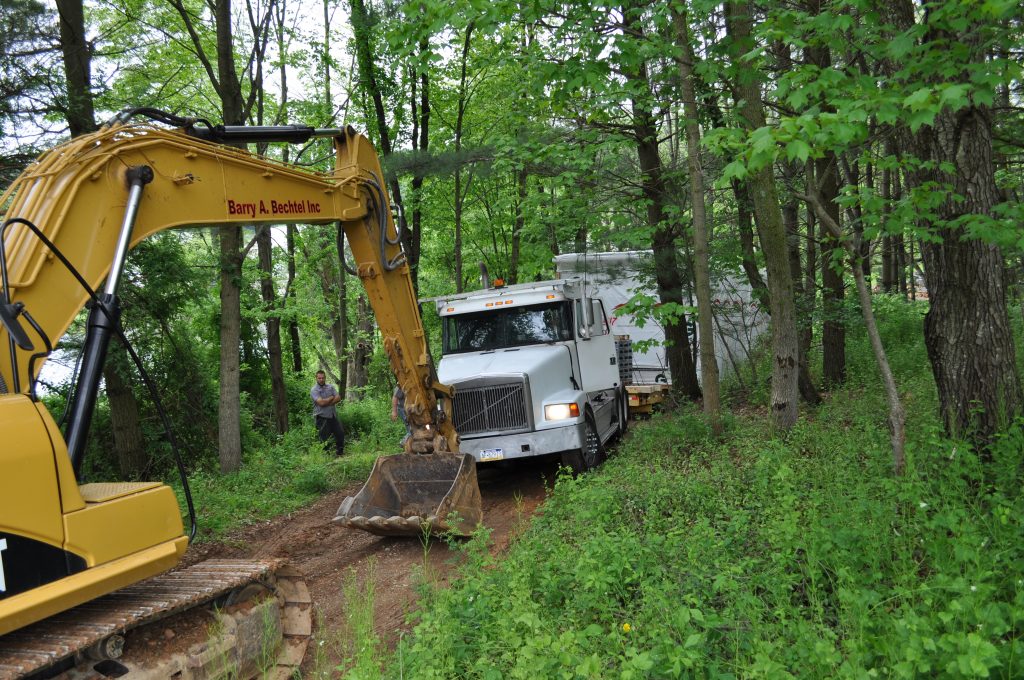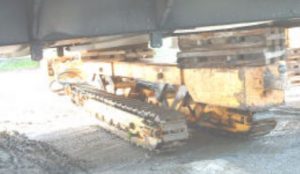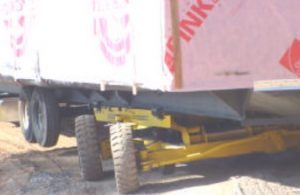Using The Right Tools To Get Modular Homes To Difficult Jobsites


Modular construction is a great way to build your new custom home. Many times a home buyers building site is in a remote area with narrow roads, narrow bridges, and tight turns. Other home buyers may live in dense urban areas with cars parked on narrow streets, have powerlines over the sidewalk, and have a constant high traffic volume, and with almost zero lot clearances. Because of the perceived access issues homeowners that have researched building modular home and decided it is a better way to build just give up on the option because they don’t understand how such large modules could ever get to their home site. The real story is that very few home sites are inaccessible. The industry had developed some pretty cool tools and equipment that can make what looks to be impossible, possible.
Having the Right Tool for the Right Job
A module is a large “box” or section of a modular home. Most modules come in widths of 12, 14, or 16 feet wide. In some regions of the country a home section can be up to 20 feet wide. A homes length can vary. Smaller homes have modules are that are 28 feet long and possibly smaller. Larger homes can have modules that extend to 76 feet long. Imagation driving a specialized semi-truck called a Toter that is pulling a module that is 16 feet wide and 76 feet long on a narrow road or on a city street. It happens every day and is done by expert drivers pulling the modular sections on specialized trailers called a carrier. The combination of a Toter truck, a carrier, and an expert driver makes what looks impossible, possible every day.
The path to home site with a modular home is gauntlet of obstacles. Typical challenges can include things like:
- overgrown trees
- low powerlines
- telephone poles
- road signs
- tight turns
- sharp curves
- fences
The industry has been very inventive and has developed tools and equipment to help large modular sections navigate around over almost every one of these items.
Here are some descriptions of a few of them:
 Toter Truck – A home is pulled on the highway and to the home site with a specialized truck known as a Toter truck. There are many version of this type of truck. When being pulled on the main highways Toter trucks usually have tandem axles and large bodies making it ride smoothly for traveling the longer distances home sites in a region. However, on side streets and rural roads their length can limit maneuvering ability. Smaller, single axle Toters with specialized hitches that can move in multiple directions can make getting modules to a home site much easier.
Toter Truck – A home is pulled on the highway and to the home site with a specialized truck known as a Toter truck. There are many version of this type of truck. When being pulled on the main highways Toter trucks usually have tandem axles and large bodies making it ride smoothly for traveling the longer distances home sites in a region. However, on side streets and rural roads their length can limit maneuvering ability. Smaller, single axle Toters with specialized hitches that can move in multiple directions can make getting modules to a home site much easier.
 Translift – A Translift is a machine that is basically a steel I-beam on tracks. This machine can be maneuvered under a modular carrier to lift it and then move the carriers from side to side. While it doesn’t have the range of motion that a Jade has, it is faster to get into position when all that is needed is a little help to get around a tight turn.
Translift – A Translift is a machine that is basically a steel I-beam on tracks. This machine can be maneuvered under a modular carrier to lift it and then move the carriers from side to side. While it doesn’t have the range of motion that a Jade has, it is faster to get into position when all that is needed is a little help to get around a tight turn.
 House Cat or Tug – A house cat is basically a mini bulldozer that is remote controlled. An operator controls the miniature unit that is actually very heavy but very nimble. It can make very sharp turns in very tight areas. Because of its weight and tracks, it is also very good at getting modular sections up steep hills and mountains. While it may move slowly, speed isn’t the consideration when it comes to getting a houses modules to the site location.
House Cat or Tug – A house cat is basically a mini bulldozer that is remote controlled. An operator controls the miniature unit that is actually very heavy but very nimble. It can make very sharp turns in very tight areas. Because of its weight and tracks, it is also very good at getting modular sections up steep hills and mountains. While it may move slowly, speed isn’t the consideration when it comes to getting a houses modules to the site location.
 Jade – A Jade is a piece of equipment that attaches to the rear of the frame of the carrier used to transport a module to a home site. The wheels of the Jade are remote controlled and the piece of equipment can also lift the carrier vertically. This machine allows an operator to have an extreme range of motion when navigating bends, curves, and turns with long modules.
Jade – A Jade is a piece of equipment that attaches to the rear of the frame of the carrier used to transport a module to a home site. The wheels of the Jade are remote controlled and the piece of equipment can also lift the carrier vertically. This machine allows an operator to have an extreme range of motion when navigating bends, curves, and turns with long modules.
Even with all of this specialized equipment, there a few occasions when a road is too narrow to travel or a bridge isn’t rated for the weight of a module. In those unique instances a modular home can’t be delivered to the home site thereby eliminating the use of modular construction for a new custom home.
Built for the Journey
Modular construction has gotten better and stronger over the years. Having the best and most sophisticated equipment to get modules to home sites wouldn’t matter if the home was destroyed on arrival. A modular home is built to take the stresses of the trip to get to a home site. It is designed to be lifted with a crane using as little as two straps or cables and placed gently on the foundation. Resting on a foundation is about the easiest thing the modular home has to do. However, it was structurally built to withstand the journey its final location.
RELATED: SETTING EXPECTATIONS: A MODULAR HOME INSTALLATION
Imagine the engineering behind the modular home design that is needed to insure the modular home can take the trip to every home site every time. Now imagine putting a home that was built onsite to the same test. What do you think would happen? Now imagine how much better you can feel knowing your family is protected every day in a home that was built to meet the rigors required of a modular home.
Taking Advantage of the Modular Solution
I know I am biased, but the ability to provide custom homes built in a factory just makes sense. The protection from the weather, the value that can be achieved, and the quality that can be delivered all add up to make modular construction the best method for providing a custom home. But the reality is that you have to be able to deliver the home’s modules to a site and you have to be able to do it cost effectively. The industry has created highly specialized equipment to get modules practically anywhere. In those few instances where a site is just unreachable, a home buyer can’t take advantage of the benefits modular construction has to offer.
Very few limitations exist when designing a home that will be built using modular construction. A professional builder that really understands construction and the modular method will evaluate a complex home project to determine how best to build it. In those few rare instances where a home’s unique design can’t use nodular construction, it can be provided cost effectively using another building system.
The post Using The Right Tools To Get Modular Homes To Difficult Jobsites appeared first on Impresa Modular.




